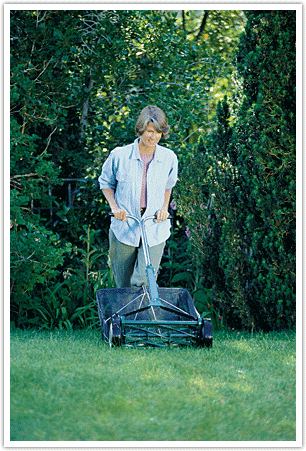Maintenance: Lawn Care & Irrigation

Return to Landscape Guide Main Page
Guide to Assigned-Day Watering and Lawn Care in the Truckee Meadows
Here in the high desert, lawns and other plants need strong root systems to stay healthy. This guide is designed to help you keep your yard green and healthy throughout the year, while encouraging responsible water use at all times.
During the summer, demand on the water system is extremely high. Our customers' water usage increases 400%—or about 100 million gallons per day system wide. Outdoor watering is the primary reason for this increase. Therefore, it is especially important for all customers to manage their usage during the summer. The Assigned-Day watering program is the cornerstone for efficient water management throughout the year. A direct benefit of the program is the balance and management of peak-day consumption throughout our water system.
This has helped TMWA avoid costly facility expansions that would increase rates for all our customers. As an added bonus, responsible water use at home and at work saves money on your water bill.
So, when preparing and irrigating your yard throughout the year, be sure to follow these helpful tips. You will keep your landscape healthy and water demands down for the entire community, all while saving money on your bill.
Mowing
De-thatching and Aerating
Fertilizing
Watering in our High-Desert Region
Weed and Pest Control
Lawn Care Throughout the Year
Mowing
Mowing heights influence the health and vigor of your lawn. In addition, mowing affects your lawn's root development, transpiration of water through the grass blades, weed resistance and photosynthesis (the food-producing process). Mow your lawn at the correct height to prevent "sun scald."
Almost all of the grasses in the Truckee Meadows are classified as cool season grasses and include bluegrass, fescues and ryegrass. These are likely to grow taller than the warm season grasses of southern climates. With this natural ability for growth, two to three inch deep mowing heights are recommended for these grasses. In addition, remove no more than 1/3 of the leaf blade. Keeping your lawn at this height gives the blades and soil some shade and will discourage weeds from sprouting.
- Always use a sharp blade when mowing your lawn. A dull blade rips and shreds the grass blades, leaving the ends jagged and brown. In addition, torn and shredded tips are more prone to diseases.
- Sharpen the blades of a reel mower every year. Rotary mowers should be sharpened monthly.
- Mow in alternate patterns, which aids in reducing ruts and compaction.
- Never mow a wet lawn. Wet lawns will clog your mower and create ruts in the turf.
- Leave clippings on the lawn. They will decompose, releasing nitrogen back into the soil. Plus, grass clippings are 90% water and they don't create thatch.
Cool Lawns Are Healthy Lawns
Transpiration is the release of water from the plant to help cool itself. If grass blades are kept at the proper mow height, the water transpired from each blade is reduced. This reduction is caused by the blades shading each other and the surrounding soil.
De-thatching and Aerating
Thatch is the accumulation of leaves, sprouts and roots that build up between the soil and the blades of grass. It is often evident next to sidewalks where a lawn is raised two or more inches. Thatch prevents water, fertilizer and air from reaching the soil. Insects often live there as well, and thatch restricts root development.
How to Eliminate Thatch
To eliminate this condition, the thatch must be broken up and removed. De-thatching can be done with a power rake. Then small holes, or pores, must be made in the soil to allow air, water, fertilizer and roots to penetrate it. This process is called aeration. Punching the holes can be done with an aerator, a machine that removes small plugs from the thatch and soil.
When to De-thatch & Aerate
These operations should be done to allow the lawn to rejuvenate throughout the growing months. De-thatching should be performed in the spring while lawn is dormant and never during the growing season. Aeration, which can be done at any time, works best when turf is moist so deeper plugs can be created. Aeration and de-thatching are not one-time cure-alls; they are part of an ongoing maintenance program that every lawn should receive.
A new lawn may not need de-thatching for two or three years. An older lawn that has a build-up of thatch may need de-thatching and aerating every year.
Fertilizing
Proper lawn fertilizing will make your lawn greener, healthier and better able to resist insects and diseases. However, over-applying lawn chemicals such as fertilizers will result in excessive turf growth causing overwatering and making mowing more difficult. In addition, runoff to storm drains can harm our water supply.
Choosing a Fertilizer
To stay healthy, lawns need four pounds of nitrogen a year for each 1,000 square feet of area. Your fertilizer's composition also should vary somewhat. Fertilizer with only nitrogen can be used for the first three applications. But in the October application, use a balanced fertilizer that contains phosphorus and potassium as well as nitrogen. This will enhance root and leaf growth, as well as discourage diseases.
Four Steps to Effective Fertilizing
1. Follow the manufacturer's instructions for proper application. Fertilizer and weed control products can harm trees and shrubs.
2. Lightly water your lawn before applying fertilizer.
3. Spread the recommended rate of fertilizer using a walk-behind or whirlybird spreader, being careful not to overlap it, which may cause "burning." Don't apply fertilizer by "hand throwing," which usually results in uneven distribution.
4. When you water, use the "Water & Wait" method, making sure to stop before runoff occurs. Runoff containing fertilizer and other chemicals travels to storm water drains and pollutes the Truckee River, our main water source.
Watering in our High-Desert Region
When irrigating your yard throughout the year, be sure to follow these helpful tips to keep your landscape healthy and keep water demands down for the entire community.
-
- Water on Your Assigned DaysIf the last number of your home or business address is even (0, 2, 4, 6 or 8), water only on Tuesdays, Thursdays and Saturdays. If the last number of your home or business address is odd (1, 3, 5, 7 or 9), water on Wednesdays, Fridays and Sundays. Mondays are a no-watering day to replenish and maintain the water system.
- Water Deeper, Less Often
Deep, intermittent watering works best in our dry climate because it promotes deeper roots that survive hot weather better than shallow root systems. Light, frequent watering encourages shallow roots that dry out rapidly, especially on hot summer days.
Virtually every plant in your yard will benefit from thorough, less frequent watering. Only new lawns, plant seedlings, and a very few naturally shallow-rooted mature plants (flowering dogwood, roses, rhododendrons) will need watering often enough to keep the topsoil moist all of the time.
In our high desert, clay-based soil takes longer to absorb water—five to six times as long as sandy soils found in other parts of the West. Since most sprinklers are designed to deliver water faster than our soil can absorb it, we recommend that you use the "Water & Wait" method to help the soil to better absorb the water:
"WATER & WAIT" METHOD
Water until puddles form or just before runoff begins. Then stop and wait for the water to soak in, about one to two hours. For sloped yards where runoff begins within minutes, we recommend short run times more often through your watering day. Repeat until water reaches six to eight inches deep, which you can determine by easily pushing a screwdriver into the soil.
- Automatic SprinklersThe "Water & Wait" method can also be utilized by setting your sprinkler controller (timer) to water in multiple, shorter cycles. Instead of one long cycle for 30 minutes, adjust the controller for two start times at 15 minutes each or three cycles at 10 minutes each with one to two hours in between each start time. Thirty minutes of watering still occurs but with a technique that eliminates waste and encourages water to reach the roots and not the streets.Multiple start times should be added with the heat of the watering season. July and August are the hottest months and should have the most start times on your sprinkler system. If your irrigation controller has a percentage feature, set it for 100% during this period. The spring and fall months should have less start times or a reduced percentage, because temperatures are milder. And remember to water only on your assigned days according to the Assigned-Day watering schedule.Don't Set It and Forget It
Be sure to check your irrigation timer monthly and adjust according to watering needs and changing temperatures. - How Often To Water
When temperatures are mild (in the 60s and 70s), watering one day a week is all your landscape needs. As temperatures rise (80s and 90s), watering on your assigned days is recommended. For properly-trained yards, this is enough even during the hottest part of the summer. Please don't water when it's windy, raining or during the heat of the day. Not only can this burn your lawn but evaporation is high. In addition, TMWA rules and city ordinances prohibit watering between noon and 6 p.m. from Memorial Day through Labor Day.Become ET Savvy! Water according to local evapotranspiration rates. These ET rates and watering information can be found at www.washoeet.dri.edu. - Watering Tips for Trees & Shrubs
Since trees and lawn compete for water and trees need twice the amount of water, it is ideal to keep trees out of your lawn. When planting, dig basins around trees and shrubs to hold water directly over the roots, and provide good drainage. Newly planted trees watered by a drip system must have the emitters located close to the root ball and surrounding area. But as the tree matures, the emitters need to be relocated outward. During dry winters, remember that trees and shrubs require additional water. - Designing your garden for On-Site Rainwater Storage
Did you know that during a one-inch rain, 625 gallons of water can be collected from 1,000 square feet of roof? This water can then be used for irrigating your landscape for free! The benefit of collecting that rainwater is that ground water is recharged and watering is reduced. Also, letting the rain water infiltrate in the soil will help prevent floods in the Truckee River. Here are several ways that you can collect and store rain water for use in your garden:1. The easiest way of harvesting water in your landscape is to store it in the soil, right where the plants need it. A simple shallow swale parallel to a slope will capture the rain running down and let it soak into the ground. Another option on level properties is to dig several trenches 18 inches deep and fill them with woody mulch. Finally, you can create shallow depressed areas in the landscape where water naturally drains and plant a mulched tree in the center. Note: most often there are existing swales around the house to run the water away from the foundation of the house. These are necessary and should be kept in place. Locate your rainwater capturing swales at least 10 feet away from the house and fill it with mulch. Many plants will grow well at the edge of these swales and trenches.2. Rainwater and snowmelt can be channeled through gutters and downspouts to a storage unit. Known as rain barrels, these storage devises are best places on the south side of the house to keep the water from freezing in the winter. A 55-gallon drum is easy to come by and can be fitted with a faucet for use with a garden hose.3. Border your lawn with depressed planting beds. Watering lawn often results in runoff, and what better way to have that water you spend your money on end up in planting beds that frame your lawn and beautify your yard? The depression can be as little as six inches and should be filled with mulch to hold the moisture and keep weeds at bay.
Watering Test
The average water-use efficiency of an automatic sprinkler system is about 50 percent. In other words, for every two gallons of water applied, one gallon is wasted. So it is important to make sure your system is working to the best of its ability. To test the coverage of your irrigation system, follow these simple directions:
1. Ideally, you should have water distributed equally over your landscape from each sprinkler head. To test the coverage of your sprinklers, randomly place six same-sized tin cans over one sprinkler zone. Turn on sprinklers. At the end of the cycle, the water collected in each can should have a similar depth within one-fourth to one-half inch. If the depth varies significantly, then you may have too many sprinkler heads on the zone, or you may need to adjust sprinkler heads to obtain similar outputs of water at each one.
2. Find out how much water your sprinkler system applies in an hour. Place tin cans at four-foot intervals from a sprinkler, turn the water on for 15 minutes and measure the water in each can. Add the amount of water from all cans, divide by the number of cans and multiply by four to determine the depth in inches per hour. Lawns need about one and one-half inch to two inches of water per week during the summer.
3. If you find that your watering is inefficient, check your system for the following:
- Low water pressure
- Debris in nozzle opening
- Debris in filter at base of sprinkler head
- Leakage at pipe joints
- Obstructions in coverage such as trees or shrubbery
Weed and Pest Control
Weeds out-compete desirable grasses when lawns stop growing due to improper watering or mowing, low fertility or compaction of soil. Once weeds become established, favorable conditions must be restored for healthy turf. After diagnosing your yard, pull the weeds or use herbicides. Crabgrass, quackgrass and clover are nearly impossible to remove completely by pulling, so watch for vigorous regrowth.
Some fertilizers include herbicides in their formulas; however, use caution. These products work well on turf, but can be harmful to trees, roses, flowers and other broadleaf plants.
Also, diseases, insects and animals can harm turf. In Nevada, fungus diseases are the usual culprits and are usually the result of overwatering. To minimize turf diseases, keep grass growing evenly; mow when grass grows one-third higher than the proper height; and don't fertilize during summer. More importantly, water deeply using the "Water & Wait" method.
Lawn Care Throughout the Year
The way you water will greatly affect the health of your landscape during the growing season. When watering, be sure to follow the Assigned-Day watering schedule.
SPRING
This is the time to encourage deep root growth — usually in April and May. Water deeply once every other week to start, then water deeply once each week. Be sure to water using the "Water & Wait" method — and only on one of your assigned days. Older lawns may need de-thatching and aerating to help roots absorb water and nutrients.
SUMMER
By June, your landscape will be conditioned and ready for Assigned-Day watering through August. Be sure to continue using the "Water & Wait" method — and only water on your assigned days.
FALL
September and October are the cool down months used to prepare your landscape for its winter rest. It's best to water one day a week, tapering off to every other week as colder weather approaches. A balanced fertilizer will also help your lawn develop stronger roots and store food over the winter period.
WINTER
From November through March, your lawn will be dormant and does not require water.



